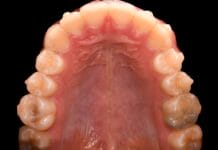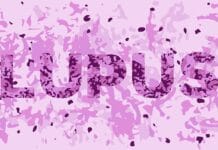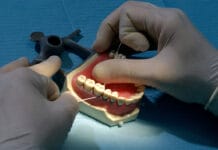1. Which of the following is an opportunistic infection, with the primary etiology being an overgrowth of fungi?
Pseudomembranous candidiasis is an opportunistic infection, with the primary etiology being an overgrowth of the fungal species Candida albicans.1 The condition is generally secondary to immune suppression, with older people and newborns being affected more frequently. Additional risk factors include chronic systemic steroid or antibiotic use and immune-compromising diseases such as HIV/AIDS.2
This type of lesion is identified by its thick white plaques that can easily be wiped off, often revealing erythematous tissue.2
References
1. McKinney, R., Olmo, H., McGovern, B. (2024, January 11). Benign Chronic White Lesions of the Oral Mucosa. StatPearls. https://www.ncbi.nlm.nih.gov/books/NBK570596/
2. Taylor, M., Brizuela, M., Raja, A. (2023, July 4). Oral Candidiasis. StatPearls. https://www.ncbi.nlm.nih.gov/books/NBK545282/
2. Linea alba presents on the buccal mucosa or the lateral surface of the tongue resulting from repeated trauma. Morsicatio buccarum usually presents bilaterally due to negative pressure pulling the buccal mucosa toward the teeth.
Morsicatio buccarum, also known as "cheek biting," generally presents on the buccal mucosa or the lateral surface of the tongue. It is characterized by excessive hyperkeratosis due to repeated trauma from biting the tissue. The inner lip may be affected, and those lesions are called morsicatio laboirum.1,2
Linea alba usually presents bilaterally as a whitish-gray horizontal line on the buccal mucosa parallel to the occlusal plane. It is caused by repetitive negative pressure pulling the buccal mucosa toward the teeth, which results in hyperkeratosis.2
References
1. McKinney, R., Olmo, H., McGovern, B. (2024, January 11). Benign Chronic White Lesions of the Oral Mucosa. StatPearls. https://www.ncbi.nlm.nih.gov/books/NBK570596/
2. Akintoye, S.O., Mupparapu, M. Clinical Evaluation and Anatomic Variation of the Oral Cavity. Dermatol Clin. 2020; 38(4): 399-411. https://www.sciencedirect.com/science/article/abs/pii/S0733863520300358
3. Oral leukoplakia is the most prevalent potentially malignant lesion of the oral mucosa, with up to 62% of oral squamous cell carcinomas related to this condition.
Oral leukoplakia is the most prevalent potentially malignant lesion of the oral mucosa, with up to 62% of oral squamous cell carcinomas related to this condition. The etiology is unclear, but some research indicates an association between oral leukoplakia and tobacco, alcohol, sanguinaria (bloodroot plants), ultraviolet radiation, trauma, betel quid chewing, genetic factors, and microorganisms.1
Oral leukoplakia presents as an irreversible, non-scrapable, slightly raised white plaque that may have a wrinkled, leathery to "dry or cracked mud" appearance. These lesions are divided into two types: homogenous and non-homogenous.1
The homogenous type has a smooth, regular, whitish surface with clearly defined margins. Non-homogenous presents with erythematous areas and can be nodular, erosive, ulcerated, or have verrucous growths. It can be localized or widespread, affecting the buccal mucosa, lips, and gingiva.1
Suggested management approaches include elimination of predisposing factors, use of beta-carotene, lycopene, ascorbic acid (Vitamin C), α-Tocopherol (Vitamin E), topical and systemic retinoic acid (Vitamin A), topical bleomycin, cold-knife surgical excision, laser surgery along with regular follow up to monitor changes.1
Reference
1. Mortazavi, H., Safi, Y., Baharvand, M., et al. Oral White Lesions: An Updated Clinical Diagnostic Decision Tree. Dent J (Basel). 2019; 7(1): 15. https://pmc.ncbi.nlm.nih.gov/articles/PMC6473409/
4. Which of the following lesions can be distinguished through a stretch test?
Leukoedema is a grayish-white lesion usually presenting bilaterally on the buccal mucosa. It is believed to be a variation of normal anatomy. Leukoedema is characterized by fluid accumulation within the epithelial cells of the buccal mucosa, with crisscrossing folds or lines within the affected area. The clinical stretch test is a distinguishing feature of leukoedema, as the white appearance disappears when the mucosa is stretched.1
Reference
1. Akintoye, S.O., Mupparapu, M. Clinical Evaluation and Anatomic Variation of the Oral Cavity. Dermatol Clin. 2020; 38(4): 399-411. https://www.sciencedirect.com/science/article/abs/pii/S0733863520300358
5. White sponge nevus is also known as Cannon disease or familial white-folded dysplasia.
White sponge nevus is also known as Cannon disease or familial white-folded dysplasia. It is a rare inherited autosomal dominant disorder. The lesions generally present at birth or early in childhood but can appear as late as adolescence.1
The lesions are symmetrical, thickened, white, corrugated or velvety, diffuse, spongy plaques of variable sizes with an elevated, irregular, and fissured surface.1
Both intraoral and extraoral sites can be involved. However, extraoral involvement is rare without intraoral manifestations. The buccal mucosa is the most commonly affected intraoral site, usually presenting bilaterally. Other intraoral sites include the ventral surface of the tongue, labial mucosa, soft palate, alveolar mucosa, and floor of the mouth. Extraoral sites include nasal, esophageal, laryngeal, and anogenital mucosa.1
White spongy nevus can cause dysphagia if the esophagus is affected. Otherwise, the condition is generally asymptomatic. If the condition is asymptomatic, no treatment is necessary.1
Reference
1. Mortazavi, H., Safi, Y., Baharvand, M., et al. Oral White Lesions: An Updated Clinical Diagnostic Decision Tree. Dent J (Basel). 2019; 7(1): 15. https://pmc.ncbi.nlm.nih.gov/articles/PMC6473409/








